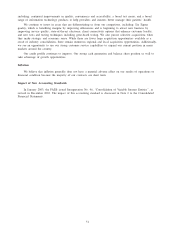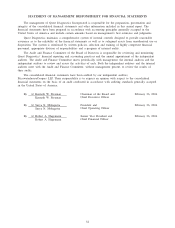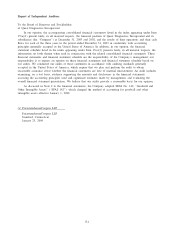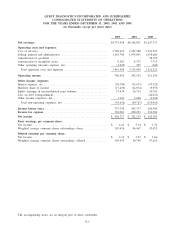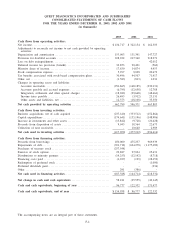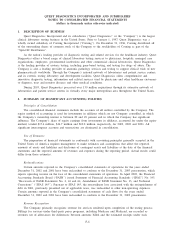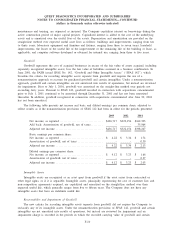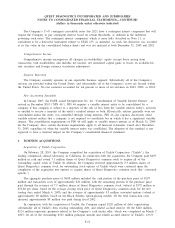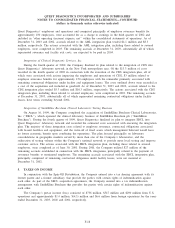Quest Diagnostics 2003 Annual Report Download - page 78
Download and view the complete annual report
Please find page 78 of the 2003 Quest Diagnostics annual report below. You can navigate through the pages in the report by either clicking on the pages listed below, or by using the keyword search tool below to find specific information within the annual report.
QUEST DIAGNOSTICS INCORPORATED AND SUBSIDIARIES
NOTES TO CONSOLIDATED FINANCIAL STATEMENTS—CONTINUED
(dollars in thousands unless otherwise indicated)
The fair value of each option grant was estimated on the date of grant using the Black-Scholes
option-pricing model with the following weighted average assumptions:
2003 2002 2001
Dividend yield .......................................... 0.0% 0.0% 0.0%
Risk-free interest rate.................................... 2.8% 4.2% 5.1%
Expected volatility ...................................... 48.1% 45.2% 47.7%
Expected holding period, in years ........................ 5 5 5
The majority of options granted in 2003 were issued prior to the declaration of the Company’s quarterly
cash dividend in the fourth quarter of 2003 and as such carry a dividend yield of 0%, thereby reducing the
weighted average dividend yield for 2003 to 0.0%.
Foreign Currency
Assets and liabilities of foreign subsidiaries are translated into U.S. dollars at year-end exchange rates.
Income and expense items are translated at average exchange rates prevailing during the year. The translation
adjustments are recorded as a component of accumulated other comprehensive income (loss) within stockholders’
equity. Gains and losses from foreign currency transactions are included within “other operating (income)
expense, net’’ in the consolidated statements of operations. Transaction gains and losses have not been material.
Cash and Cash Equivalents
Cash and cash equivalents include all highly-liquid investments with maturities, at the time acquired by the
Company, of three months or less.
Concentration of Credit Risk
Financial instruments that potentially subject the Company to concentrations of credit risk are principally
cash, cash equivalents, short-term investments and accounts receivable. The Company’s policy is to place its
cash, cash equivalents and short-term investments in highly rated financial instruments and institutions.
Concentration of credit risk with respect to accounts receivable is mitigated by the diversity of the Company’s
clients and their dispersion across many different geographic regions, and is limited to certain customers who
are large buyers of the Company’s services. To reduce risk, the Company routinely assesses the financial
strength of these customers and, consequently, believes that its accounts receivable credit risk exposure, with
respect to these customers, is limited. While the Company has receivables due from federal and state
governmental agencies, the Company does not believe that such receivables represent a credit risk since the
related healthcare programs are funded by federal and state governments, and payment is primarily dependent
on submitting appropriate documentation.
Inventories
Inventories, which consist principally of supplies, are valued at the lower of cost (first in, first out method)
or market.
Property, Plant and Equipment
Property, plant and equipment is recorded at cost. Major renewals and improvements are capitalized, while
maintenance and repairs are expensed as incurred. Costs incurred for computer software developed or obtained
for internal use are capitalized for application development activities and expensed as incurred for preliminary
project activities and post-implementation activities. Capitalized costs include external direct costs of materials
and services consumed in developing or obtaining internal-use software, payroll and payroll-related costs for
employees who are directly associated with and who devote time to the internal-use software project and
interest costs incurred, when material, while developing internal-use software. Capitalization of such costs ceases
when the project is substantially complete and ready for its intended purpose. Certain costs, such as
F-9


